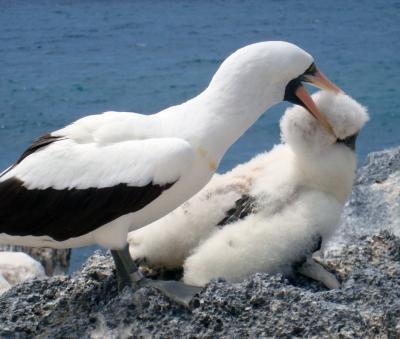
一只成年纳斯卡鲣鸟在虐待一只雏鸟。
在人类中发现的虐童“暴力循环”也在加拉帕戈斯群岛的海鸟中上演。
维克森林大学的研究人员在对纳斯卡鲣鸟的研究中首次证实,那些在幼时被施虐的受害者在长大后也会成为施虐者。这项研究发表在11月份的鸟类学杂志《The Auk》上。
“我们对许多成年鸟表现出来的对不相关幼鸟的强烈兴趣,包括粗暴行为很惊讶,”领导这项研究的生物学家Dave Anderson教授说。“一只鸟在幼年时作为施虐对象的历史预示了其在成年时的行为。”
在纳斯卡鲣鸟中,成长中的幼鸟所受到的难忘的虐待显著提高了它们在成年后表现相同施虐行为的机会。荷兰格罗宁根大学的Müller说。
这些在海洋上飞翔的海鸟群居在远离厄瓜多尔的加拉帕戈斯群岛。在纳斯卡鲣鸟中,成年鸟欺骗其他鸟的雏鸟现象非常普遍。这些鸟在地面上抚养其单个的幼崽,并且经常在出海觅食时留下幼崽无人照看。因此,这就给了成年鸟很多的机会来恐吓、殴打邻居幼崽的机会。它们经常啄咬小鸟,甚至进行性挑逗,使幼鸟处于流血和紧张状态。平均来说,雌鸟要比雄鸟更具攻击性。
幼鸟在几年之后会在它出生的群居区建巢,这使得它们成为研究虐雏对终生行为影响的理想模式。
研究人员历时三个繁殖季节收集数据,记录幼鸟所遭受的虐待或冷落,然后几年过后在同一个群居区评估这些幼鸟成年后的行为。研究人员利用脚牌来跟踪并识别这些鸟。
这些发现加强了对动物行为的理解。“这不是以被捕获的惊慌失措的动物来进行的非自然实验,而是让动物在幼时即处在自然的条件下进行的实验。结果表明,它们后来的行为受到它们所经历的社会压力的影响,”Anderson说。“在我们确定这种反应的生理学与人类的相似程度后,我们就可以开展这种不可能在人类身上进行的压力反应研究。”
维克森林大学的研究者目前正在探索对虐待的生理反应,已经发现当雏鸟在经历虐待时,其主要的鸟类应激激素肾上腺酮水平会急剧升高。激升的应激激素可能影响成年鸟的行为。
“非常有意思,许多被认为是极端复杂的人类现象可能通过相同的生理机制发生在纳斯卡鲣鸟中,这种鸟比哺乳动物在进化上更接近鳄鱼,”Grace说,“两项研究说明,纳斯卡鲣鸟鸟可能是一种开展研究人类暴力循环机制的绝佳模式生物。”


Type the text hereMaltreated nestlings exhibit correlated maltreatment as adults: Evidence of a "cycle of violence" in Nazca boobies (Sula granti)
Muller MS, Porter ET, Grace JK, Awkerman JA, Birchler KT, Gunderson AR, Schneider EG, Westbrock MA, Anderson DJ
The “cycle of violence” hypothesis implicates child abuse as a cause of later violent behavior via social transmission between generations. It has received mixed support from human research and has prompted the study of nonhuman models with comparable abuse behaviors. The underlying biology of child abuse remains a controversial subject, perhaps partly because in nonhuman animals similar behavior occurs relatively rarely in wild populations. The Nazca Booby (Sula granti), a colonial seabird, provides a nonhuman model in which maltreatment of nonfamilial young is widespread under normal living conditions. Essentially all adults show social attraction at some point in their lives to the offspring of other parents, often with a sexual and/or aggressive motivation. Here, we show a correlation between the degree to which a young bird is targeted by such adults and its own infliction of maltreatment later in life. The results provide the first evidence from a nonhuman of socially transmitted maltreatment directed toward unrelated young in the wild.







